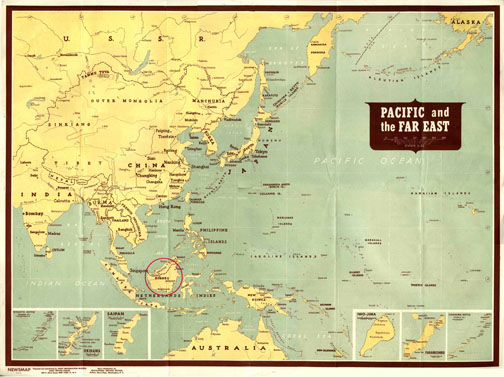The Battle of Balikpapan, 23-24 January 1942
Tonight marks the 70th anniversary of the Battle of Balikpapan, a surprise attack by four US Navy destroyers on a Japanese invasion fleet off the coast of Borneo. This battle is sometimes referred to as the Battle of Makassar Strait, and so it is often confused with another Battle of Makassar Strait that took place in February 1942, though not actually in Makassar Strait. That Battle of Makassar Strait took place in the Bali Sea, so naturally it is also known as the Action of Madura Strait. Or the Action North of Lombok Strait. Or the Battle of the Flores Sea. The obvious confusion in the naming of the battles around Borneo reflects the chaos and confusion in the weeks following the Japanese attacks throughout the Pacific in December 1941.
It also represents the widespread lack of knowledge of Pacific geography. Most people couldn’t find Borneo on a map in 1942.
Most people can’t find Borneo on a map today.

Click here to enlarge the map – will open in a new window
The battle came about after a US submarine spotted a Japanese invasion fleet headed towards Borneo, which at the time was a Dutch colony. An American surface force of two cruisers and four destroyers under the command of Rear Admiral William Glassford was dispatched to destroy the Japanese transports, but they immediately ran into trouble. The USS Boise, Glassford’s flagship, hit an uncharted rock and had to turn back. He transferred to the USS Marblehead, but that ship soon developed engine trouble and had to turn back as well. So the destroyers John D. Ford, Pope, Parrott and Paul Jones were left to make the attack on their own.
They caught the Japanese convoy at anchor and completely by surprise. The four destroyers fired all of their torpedoes in a single pass and departed before Japanese escorts could retaliate. At no cost to themselves, the four US destroyers sank four Japanese transports and a patrol boat.
Although the American victory in the Battle of Balikpapan made for uplifting headlines, it was of negligible value. Strategically, it was a loss for the Allies. Although four Japanese transports were sunk, they were all empty, having already landed their troops. Borneo and its rich oilfields fell to the Japanese soon after the battle.
Tactically, the Battle of Balikpapan proved to be a fluke. A victory by US Navy surface forces, at night, involving torpedoes that actually worked was a rare thing in 1942. American training before World War II had put little emphasis on night operations, while the Japanese had refined night combat to an art. Likewise, American torpedoes soon developed a reputation for failure due to faulty components, while the Japanese Long Lance torpedo was unequaled for range and hitting power throughout the war.
The confidence gained in this victory was to be shattered by a string of defeats in night battles at the hands of the Imperial Japanese Navy, culminating in the disastrous Battle of Savo Island in August 1942. Starting from Balikpapan, it would take the US Navy nearly a year to master naval combat at night, and even longer still to produce reliable torpedoes.
This post by Curator Eric Rivet.
- Posted :
- Post Category :
- Tags :
- Follow responses to this entry through the RSS 2.0 feed. You can skip to the end and leave a response. Pinging is currently not allowed.




Leave a Reply